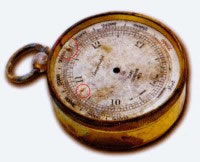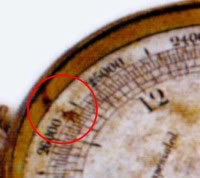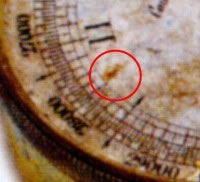
Left: George Mallory and Andrew Irvine © RGS/The Sandy Irvine Trust, from "Ghosts of Everest" ; Right: 1924 North Face locations © Pete Poston
| Photoanalysis | Routes & Maps | Video & Books | Contact Me |

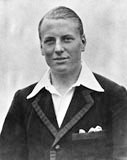
"I'm quite doubtful if I shall be fit enough. But again I wonder if the monsoon will give us a chance. I don't want to get caught, but our three-day scheme from the Chang La will give the monsoon a good chance. We shall be going up again the day after tomorrow. Six days to the top from this camp!"
--from George Mallory's last letter to his wife prior to disappearing on Mt. Everest with his partner Andrew "Sandy" Irvine in 1924
"My face is in perfect agony. Have prepared two oxygen apparatus for our start tomorrow morning".
- Sandy Irvine's last diary entry

New Evidence in the Mystery of Mallory and Irvine?
© Pete Poston, May 28, 2002
Revised: Aug 20, 2009:
I was surprised to read in "Tatort Mount Everest: Der Fall Mallory" about my discovery of rust stains on the face of Mallory's altimeter. I wrote this article back in 2002, but to be honest, after reflecting on it further, I didn't believe my conclusion that the rust mark that matched the elevation of ice ax site to within 100' (30 meters) was corroborating evidence that the fatal fall really did occur there.
I'm still not sure about it because there was probably only one hand on the altimeter like earlier Cary altimeters, and so once the hand rusted and broke apart, the two corresponding rust marks should have occured in random locations. Hemmleb asks if it's just coincidence that one of them roughly corresponds to the ax site, as I did in 2002, so I'll leave it to the reader to decide.
It's also interesting that, like the watch crystal, the altimeter glass was missing and no fragments of either were found in Mallory's pocket. So I'm open to the idea of a "mini-fall" at the ax site during the afternoon blizzard, breaking the glass in the altimeter (and maybe the watch). One or both of the climbers could have been injured in this mini-fall, perhaps setting the stage for the final fatal fall lower down in the Yellow Band. This assumes that Xu Jing and Chhiring Dorje's sightings aren't true, a consideration I don't discount.
This idea was mentioned in a five-part series of articles written by Hemmleb and me back in 2004, but not given attribution in his new book. These articles can be found on MountEverest.net here: Part 1, Part 2, Part 3, Part 4, Part 5.
Of course, this means if Xu Jing or Chhiring Dorje really did see an old body on the NE Ridge at over 8400 meters, then you could argue that Irvine remained at the ax site just below the ridge crest, and Mallory vanished from sight in the driving snow and mist below, only to suffer a final, fatal fall near the bottom of the Yellow Band. Irvine could then have continued along the Ridge to his final resting place. The major flaw in all this is I can't imagine Irvine leaving his mate and not climbing down to look for him. This scenario is similar to Tom Holzel's recent theory, except he theorizes both climbers slipped off of the Ridge onto the Face below, where he has photographically identified a body further down the Face he believes is Irvine.
OK, here's the original article.
The 1999 Mallory and Irvine Research Expedition accomplished the incredible feat of locating the remains of George Mallory high on the, windswept upper slopes of the North Face of Mt. Everest. They returned with many important artifacts and new clues about the climb [1]. Included in these artifacts was an oxygen bottle located at the base of the 1st Step at an altitude of 27,820 feet (8480 m). On Mallory's body, an altimeter was found in a jacket pocket, and a wristwatch was found tucked away in his right pants pocket. The rust stains on the watch face indicate that the watch had stopped at either 1:25 - or if using the stub of the minute hand instead of the stain - 1:55. Whether the time was in the morning or afternoon is not possible to determine. The watch mechanism was examined by a watch expert and determined to be undamaged, and therefore the watch had run down on its own. Lacking any other further evidence, any interpretation of the party's movements based on the watch alone is tempting but risky.
Tempting because the time is not inconsistent with another aspect of the mystery, and that is the famous sighting of the pair somewhere on the Northeast Ridge by fellow expedition member Noel Odell. Odell was climbing several thousand feet below in support on his way up to their high camp at 26,700 feet (8140 m). In one of the most famous passages of mountaineering history, Odell reported observing the climbers through a sudden "clearing of the atmosphere", ascending a "prominent rock step" at 12:50 PM before the mists closed in on the pair forever. So if the watch is used as a clue, then it could instead mark the time of an accident that occurred an hour or so after Odell's sighting. Later in the day, Odell reported a short but intense snowstorm that began at around 2 PM and cleared up by 4 PM. At this time there were no further sightings of the climbers, although Odell repeatedly scanned the upper slopes for them on his descent to the North Col.
Odell himself was never able to decide on just which step he saw them, and after initially believing he had seen them on the higher and more technically difficult 2nd Step, he later changed his mind to the lower and technically easier 1st Step. The debate has raged for decades on which step Odell saw them, or even as to whether or not Odell actually saw anything at all. The British 1933 Expedition was respectful of Odell's truthfulness [2], but politely suggested that Odell's sighting was a trick of perception instead - perhaps what he had actually seen was two rocks on the 2nd Step instead. This is exactly what happened to two 1933 climbers Eric Shipton and Frank Smythe, who thought they had caught a glimpse of fellow climbers Wyn Harris and Wager climbing the 2nd Step on a summit attempt. So if you are to believe Odell at all, the consensus of opinion is that he must have seen them on the 1st Step, something Odell himself later admitted, albeit reluctantly.
The 1933 Expedition also discovered Andrew Irvine's ice ax on the Northeast Ridge, located approximately 250 meters east of the 1st Step at an elevation of 27,760 feet (8460 m), and some 20 meters below the ridge crest on technically easy ground. This same ground has been described by the 2001 Mallory and Irvine Research Expedition to be as easy as walking along a sidewalk [3], so it's hard to understand how a slip could have originated from this location. The relatively undamaged condition of Mallory's body seems to indicate a fall from lower down the Face and therefore not from the ax site, an opinion based on comparison with the broken, contorted bodies of modern climbers known to have fallen from similar places on the Northeast Ridge. The condition of Mallory's body has led Everest historian Jochen Hemmleb and other members of the 1999 research expedition to believe that the pair must have fallen from a position lower down the crumbling limestone cliffs of the Yellow Band. This has been combined with Wang Hong Bao's famous discovery of the body of an "English Dead" [4] within a short distance of the 1975 Chinese expedition Camp 6, and has led to the theory that Wang had stumbled on the body of Andrew Irvine because of differences in the physical description of this body and Mallory's body. The 2001 Research Expedition was able to locate this 1975 Chinese camp, but the body of Irvine was not found, along with the camera he is purported to be carrying. This expedition did determine that Mallory was only 150 meters west and 20 meters below this camp locality however.
Such are the basic facts of the mystery. Can anything further be learned from them? Returning to the watch clue, if one is willing to believe that the rust stains record the time of the accident, then additional inferences can be made of their movements after Odell's famous sighting. The historian Tom Holzel has done just this in a recent article published in High Mountain Sports Magazine [5]. Holzel has tied together the basic facts of the case: Odell's sighting on the 1st Step at 12:50 PM, the time indicated by the rust stains on the watch at either 1:25 or 1:55 PM, and the location of the ice ax to explain what must have happened to the climbers. Holzel theorizes that the pair - knowing that it was late in the day and that the summit was out of the question - might have climbed the 1st Step to take photographs and reconnoiter the Ridge Route for a future party to attempt. Holzel also emphasizes how Mallory would not have taken any unnecessary risks with his young, inexperienced protegé - the prevailing ethic at the time. So they would have descended from the step shortly after 1 PM, plenty of time to reach the ice ax site only 250 meters away along the technically easy portions of the Ridge by about 1:55 PM. It is here that the fatal slip occurred, perhaps at the onset of the afternoon snow squall that hit at about the same time as reported by Odell. On these now very icy, snowy, downward-sloping slabs, perhaps Mallory - who most certainly would have been leading the way - lost his hob-nailed balance on a slab and plummeted down the rocks, dragging Irvine - who threw his ice ax aside to hold the rope with both hands - to their deaths.
So there are two schools of thought on the mystery. What is needed is additional corroborative evidence to support one hypothesis over the other. A previously unreported new clue from the altimeter [Figure 1] may provide just that evidence. Closer examination of the face of the altimeter reveals that there are two sets of rust marks present. The first set consists of a mark on the altitude scale at 25,650 feet (7820 m), and a circular rust mark on the inside surface of the casing at the same elevation [Figure 2]. The second rust mark is found below the scale at 27,850 feet (8490 m) [Figure 3]. In addition to these marks, it is known that the glass and hands from the altimeter were missing, and examination of Mallory's jacket pocket revealed no trace of either.
Can these two previously unreported rust marks be interpreted in a way consistent with the rest of the evidence? The first and obvious answer is no because the presence of two pairs of marks at two separate altitudes is contradictory, and indicates the hand or hands were dislodged during the fall and simply rusted in place in random locations. In addition, an elevation of 25,650 feet from the rust mark in Figure 2 is about 1000' below Mallory's resting place of 26,770 feet (8160 m), and would preclude any possibility of the altimeter surviving the fall and continuing to point to the new elevation (although it possible that simple atmospheric fluctuations could have caused this discrepancy before the hand locked up from rusting). The only other relevant elevation might be the 1924 Camp 5, which was at around 25,500', but there is no reason to link the altimeter to this lower camp visited several days previously. An additional difficulty in relying on the rust stains as credible evidence is the presence of two sets of marks; unless there were originally two hands on the altimeter. At present it is not known how many hands the altimeter originally had, although an examination of the Royal Geographical Society archives may yield useful information. If there were two hands however, then it's possible that the second hand was actually used to MARK an altitude, analogous to a barometer where the maximum (or minimum) barometric pressure can be marked by the user.
Figure 1 |
Figure 2 |
Figure 3 |
All photos © 1999 Mallory & Irvine Research Expedition |
||
So at this time the following hypothesis is presented:
Norton told Mallory that Camp 6 had been established at 26,800' [6], but it is now known from the discovery of their high camp by the 2001 research expedition that this camp was actually at 26,700'. And since altimeters need to be frequently calibrated to be of any use, it is not unreasonable to suppose that Mallory would have recalibrated his altimeter to 26,800' on the morning of summit day. But then the altimeter would have been set 100' too high, and so the rust mark at 27,850 ' is actually at 27,750'.
Is it just coincidence that this is exactly the elevation of the ice ax site?
Maybe so. It's certainly possible to do away with the assumption that Mallory's altimeter was calibrated 100' too high, and note that the elevation corresponds with the bottle elevation, or to perhaps speculate that the altimeter was 150' too low and that the elevation coincides with Odell's sighting of the pair at the top of the 1st Step. There are many interpretations possible, but only one is consistent with the preponderance of evidence to this point - a fall from the ax site.
Even if further evidence determines that there was only one hand on the altimeter, it seems likely that the rust mark indicates at the very least that something dramatic caused the altimeter to stop working at around 28,000' feet on the upper slopes of the North Face of Mt. Everest on June 8, 1924.
| 1. |
| 2. |
| 3. |
| 4. |
| 5. |
| 6. |

Articles and Editorials
![]() Harvey V. Lankford, MD, has written a paper documenting the origin of the term "Glacier Lassitude" as a diagnosis for the debilitating effect of altitude as experienced by members of the early British Everest expeditions.
Harvey V. Lankford, MD, has written a paper documenting the origin of the term "Glacier Lassitude" as a diagnosis for the debilitating effect of altitude as experienced by members of the early British Everest expeditions.
![]() My new theory about Mallory and Irvine's last climb, where I believe Odell's sighting was erroneous, and have them taking the Couloir route instead.
My new theory about Mallory and Irvine's last climb, where I believe Odell's sighting was erroneous, and have them taking the Couloir route instead.
Part 1: the ascent
Part 2: the descent
![]() Warwick Pryce is a new researcher who has arrived on the scene, and he has a new theory about how Andrew Irvine could have been the first person to stand on the top of the world.
Warwick Pryce is a new researcher who has arrived on the scene, and he has a new theory about how Andrew Irvine could have been the first person to stand on the top of the world.
Wim Kohsiek has a new interpretation of what Mallory's altimeter can tell us based on scientific applications of meterology.
Mallory and Irvine researcher Wim Kohsiek has two new thought-provoking articles about Mallory's watch and Irvine's location:
Mallory's Watch - Does it Really Point to 12:50 PM?
1924 Oxygen by Richard McQuet and Pete Poston
Why the Camera and Film are not Doomed to Destruction!
The Politics of Mallory and Irvine
Why Andrew Irvine Will Not be Found in a Sleeping Bag! Part 1 and Part 2 on ExplorersWeb
Chomolungma Nirvana: The Routes of Mount Everest
Rust Marks on Mallory's Altimeter
Mystery of Mallory and Irvine's Fate Google Earth Tour - my own ideas in 3-D with audio!
Little Known Free-Solo Ascent of the Second Step in 2001 by Theo Fritsche - I should never have written this - Anker and Houlding deserve credit for the first free ascent
Criticisms of the 2004 EverestNews.com search for Irvine --
The Mystery of Mallory and Irvine's Fate (with J. Hemmleb): Part 1, Part 2, Part 3, Part 4, Part 5.
Mallory and Irvine - Comments on the 'real Second Step' route: Part 1 and Part 2
Conrad Anker's comments on the unlikeliness of a direct route up the prow of the 2nd Step
Articles about my heroes Walter Bonatti and Chris Bonington --
Spilling the Beans - Lino Lacedelli's Book "Price of Conquest: Confessions from the First Ascent of K2" Part 1 and Part 2
The Life and Climbs of Chris Bonington, Part 1, Part 2, Part 3, Part 4, Part 5 final - interview
About Me
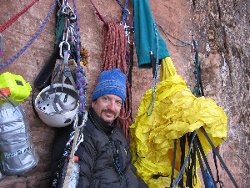 Celebrating my 50th birthday on pitch 3 of Prodigal Son, Zion National Park, Utah
Celebrating my 50th birthday on pitch 3 of Prodigal Son, Zion National Park, Utah
In my free time, I love to photograph and hike the spectacular redrock wilderness of the Colorado Plateau - please visit my Colorado Plateau Homepage.
And for most of my life I've been fascinated with the history, people, and culture of the Himalayas and Karakoram - browse my Mount Everest Trek (1996), Overland Journey from Kathmandu to Lhasa (2000), and K2 Base Camp Trek (2007) webpages.
As for my employment, I work for Western Oregon University where I have been a Professor of Chemistry for the last 20 years. My research interests are in applications of Laser Raman Spectroscopy to such diverse fields as Nanotechnology, Analytical Chemistry, and even a bit of Achaeology through the study of rock art pigments found in the Colorado Plateau. You can access my academic webpage here.

|
Copyright (c) 2004-2022 Pete Poston. All rights reserved. Visitor's Agreement |
